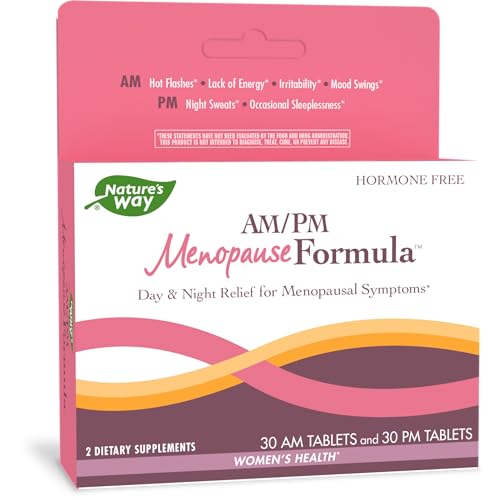
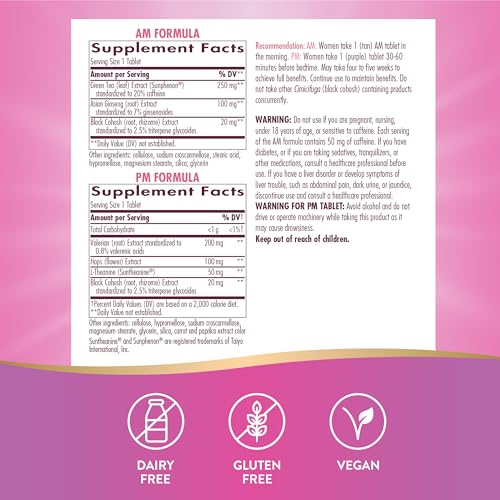
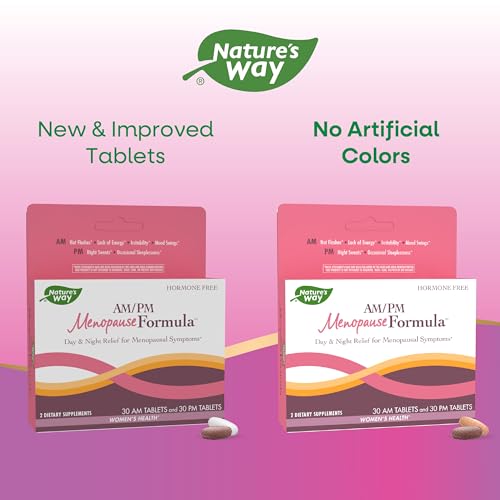
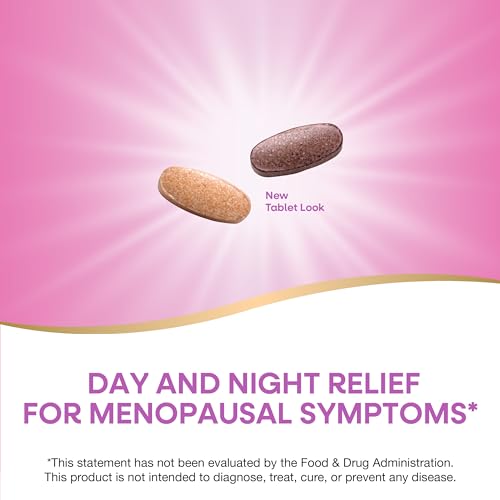
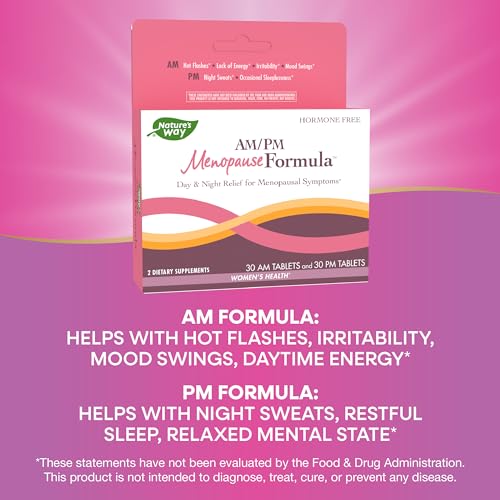
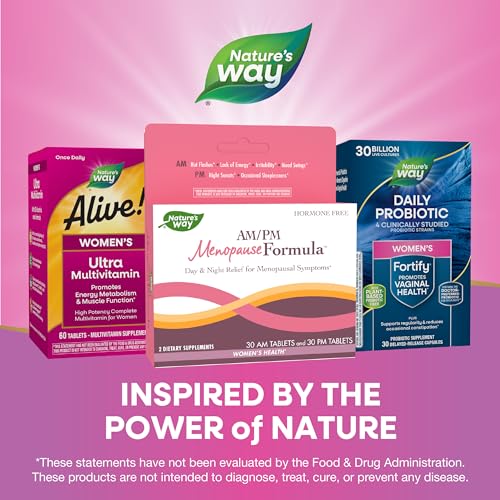
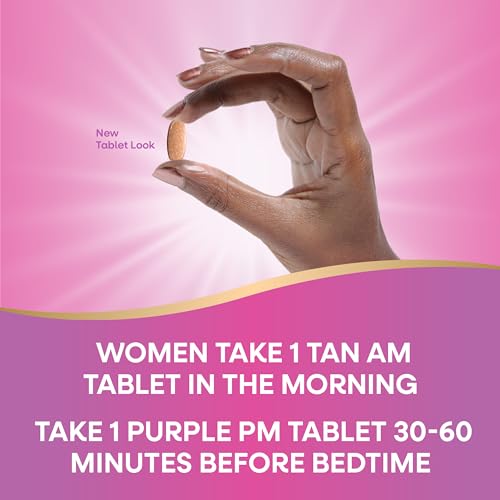
Nature's Way Hormone Balancing Supplement - Day & Night Relief for Menopause - 60 Tablets


Humulus Lupulus (Hops)
Medium RiskHumulus lupulus, commonly known as hops, is a flowering plant used primarily in brewing beer for flavoring and stability. Its components contribute to the bitterness and aroma of beer, while also acting as a natural preservative. Hops are also utilized in herbal medicine for their sedative properties.
Sustai Insights
Humulus lupulus offers functional benefits, such as flavor enhancement and preservation in food and beverages. While generally deemed safe, moderate concerns exist regarding its allergenic potential. It poses low risks of carcinogenicity and reproductive toxicity, with no significant environmental hazards noted. Regulatory bodies do not impose severe restrictions on hops, positioning it at a moderate risk level overall. Safe usage practices include ensuring proper sourcing and monitoring for allergens. Alternatives like other bittering agents may be considered for those with sensitivities. Overall, hops are a medium-risk ingredient.
Sand
Low RiskSand is loose, granular particles of worn or disintegrated rock, primarily composed of silica. It is commonly used as an abrasive, filler, or in construction and landscaping for its structural properties.
Sustai Insights
Sand offers functional benefits such as providing bulk and texture in various products, and it is generally considered to have low health risks, with minimal concerns regarding carcinogenicity, allergies, or reproductive toxicity. Environmentally, sand does not contribute significantly to pollution and is not bioaccumulative. Regulatory bodies do not impose restrictions on sand usage, maintaining its low-risk status. Safe usage practices should be followed to avoid inhalation of fine particles. Overall, sand is a low-risk ingredient with no notable negative impacts.
Cimicifuga Racemosa Root
Low RiskCimicifuga racemosa root is a plant material derived from the black cohosh plant, commonly used in herbal remedies, particularly for women's health, including menopausal relief. It is often included in dietary supplements and herbal formulations for its purported therapeutic properties.
Sustai Insights
Cimicifuga racemosa root offers functional benefits, particularly in alleviating menopausal symptoms and promoting hormonal balance. It is generally regarded as safe, with low concerns regarding carcinogenicity, allergies, and reproductive toxicity. However, potential health risks include mild gastrointestinal discomfort in some individuals. Environmental impacts are minimal, and it does not bioaccumulate or pose significant pollution risks. Regulatory status is favorable, with no current restrictions. Overall, the risk level is low, and it may serve as a suitable option in formulations aimed at women's health.
Cellulose
Low RiskCellulose is a natural polysaccharide derived from plant cell walls, primarily used as a thickening agent, stabilizer, and emulsifier in cosmetic formulations. It is known for its ability to improve texture and consistency in products.
Sustai Insights
Cellulose serves as an effective thickening and stabilizing agent, enhancing product texture while being biodegradable and derived from renewable sources. Health risks are minimal, with low concerns regarding carcinogenicity, allergies, and reproductive toxicity. Environmental impacts are also low, as cellulose does not contribute significantly to pollution or bioaccumulation. Regulatory agencies have not issued restrictions on its use. Overall, cellulose presents a low risk profile, making it a suitable ingredient choice in cosmetics.
Stearic Acid
Low RiskStearic acid is a naturally occurring fatty acid commonly found in animal and vegetable fats. It functions primarily as an emulsifier, thickener, and stabilizer in cosmetic and personal care products, providing texture and consistency.
Sustai Insights
Stearic acid offers functional benefits such as effective emulsification and stabilization of formulations. It is derived from renewable sources and is biodegradable, contributing to its sustainability profile. Health risks are low, with minimal concerns regarding carcinogenicity, allergies, or reproductive toxicity. Environmental risks are also low, with no significant pollutants or bioaccumulation concerns noted. Regulatory bodies, including the FDA, do not impose restrictions on its use. Overall, stearic acid is assessed as low risk, and its safe usage practices are well-established, with no significant alternatives needed.
Hydroxymethylcellulose
Low RiskHydroxymethylcellulose is a synthetic polymer derived from cellulose, primarily used as a thickening agent, emulsifier, and film-forming agent in various personal care and cosmetic products. It enhances texture, stability, and moisture retention, making it suitable for use in creams, lotions, and gels.
Sustai Insights
Hydroxymethylcellulose serves effectively as a thickener and stabilizer, contributing to product texture and moisture retention. It is considered low risk for health concerns such as carcinogenicity, allergies, and reproductive toxicity. Environmentally, it is not classified as a pollutant or bioaccumulative, aligning with regulatory standards in multiple regions. Overall, its risk level is assessed as low, with no significant adverse effects reported. Safe usage practices should be followed, and while alternatives exist, hydroxymethylcellulose remains a suitable choice in formulations.
Valeriana Officinalis (Valerian) Root
Low RiskValeriana officinalis (valerian) root is a plant material commonly used in herbal supplements and traditional medicine. It is primarily recognized for its potential calming effects, often utilized to support relaxation and improve sleep quality.
Sustai Insights
Valerian root offers functional benefits such as promoting relaxation and aiding sleep, with low concerns regarding carcinogenicity, allergies, and reproductive toxicity. It is not currently restricted by regulatory bodies like the FDA. However, while generally considered safe, excessive use may lead to mild side effects. Environmental risks are minimal, with no significant pollutant or bioaccumulation concerns. The overall risk level is assessed as low, and alternatives may include other herbal sedatives like chamomile or passionflower.
Magnesium Stearate
Low RiskMagnesium stearate is a magnesium salt of stearic acid, commonly used as a lubricant and anti-caking agent in pharmaceuticals and cosmetic products. It helps in the manufacturing process by preventing ingredients from clumping together and ensuring even distribution in formulations.
Sustai Insights
Magnesium stearate is recognized for its functional benefits as a lubricant and anti-caking agent, enhancing product stability. It is considered low risk regarding health concerns, including carcinogenicity and allergenic potential, with no significant environmental hazards reported. Regulatory bodies, including the FDA, have not imposed major restrictions, supporting its safe use in various applications. Recommended usage levels are typically low, maintaining safety in formulations. Overall, the ingredient is assessed as low risk, with no significant adverse health or environmental impacts identified.
Croscarmellose
Low RiskCroscarmellose is a cross-linked polymer of carboxymethylcellulose, primarily used as a disintegrant in pharmaceutical formulations and as a thickening agent in food and cosmetic products. It facilitates the breakdown of tablets in the digestive system and enhances the texture of various formulations.
Sustai Insights
Croscarmellose is valued for its effective disintegration properties in pharmaceuticals and its role as a thickener in various formulations. It is not associated with significant health risks, including carcinogenicity or allergenic potential, and is currently not restricted by regulatory bodies. Environmentally, it poses low risks regarding pollution and bioaccumulation. The ingredient has a low overall risk assessment, making it a safe choice in product formulations. Safe usage practices should be adhered to, and while alternatives exist, they may not replicate its specific functional benefits.
Vegetarian Glycerin
Low RiskVegetarian glycerin, also known as glycerol, is a colorless, odorless, and viscous liquid derived from plant sources. It is primarily used as a humectant, solvent, and emollient in various personal care products, helping to retain moisture and improve texture.
Sustai Insights
Vegetarian glycerin offers functional benefits as an effective humectant, promoting hydration and skin smoothness. It is biodegradable and typically sustainably sourced. Health risks associated with glycerin are low, with no significant concerns for carcinogenicity, allergens, or reproductive toxicity. Environmental risks are minimal, and it is not subject to major regulatory warnings. Overall, the risk level for this ingredient is low, making it a safe choice in formulations. Safe usage practices include ensuring proper concentrations in products, and alternatives such as propylene glycol exist but may have differing properties.
Black Tea
Low RiskBlack tea is a type of tea made from the leaves of the Camellia sinensis plant, fully oxidized during processing. It is widely consumed and serves various purposes in food and beverage products, primarily for its flavor and potential health benefits.
Sustai Insights
Black tea offers functional benefits such as antioxidant properties and flavor enhancement. It is generally regarded as safe, with low concerns regarding cancer, allergies, and reproductive toxicity. Environmental risks are minimal, and it is not classified as a pollutant. Regulatory bodies have no current warnings or restrictions on its use, resulting in an overall low risk assessment. Safe usage practices include moderation in consumption. Alternatives like green tea may provide similar benefits with potentially less caffeine.
Sand
Low RiskSand is loose, granular particles of worn or disintegrated rock, primarily composed of silica. It is commonly used as an abrasive, filler, or in construction and landscaping for its structural properties.
Sustai Insights
Sand offers functional benefits such as providing bulk and texture in various products, and it is generally considered to have low health risks, with minimal concerns regarding carcinogenicity, allergies, or reproductive toxicity. Environmentally, sand does not contribute significantly to pollution and is not bioaccumulative. Regulatory bodies do not impose restrictions on sand usage, maintaining its low-risk status. Safe usage practices should be followed to avoid inhalation of fine particles. Overall, sand is a low-risk ingredient with no notable negative impacts.
Cimicifuga Racemosa Root
Low RiskCimicifuga racemosa root is a plant material derived from the black cohosh plant, commonly used in herbal remedies, particularly for women's health, including menopausal relief. It is often included in dietary supplements and herbal formulations for its purported therapeutic properties.
Sustai Insights
Cimicifuga racemosa root offers functional benefits, particularly in alleviating menopausal symptoms and promoting hormonal balance. It is generally regarded as safe, with low concerns regarding carcinogenicity, allergies, and reproductive toxicity. However, potential health risks include mild gastrointestinal discomfort in some individuals. Environmental impacts are minimal, and it does not bioaccumulate or pose significant pollution risks. Regulatory status is favorable, with no current restrictions. Overall, the risk level is low, and it may serve as a suitable option in formulations aimed at women's health.
Cellulose
Low RiskCellulose is a natural polysaccharide derived from plant cell walls, primarily used as a thickening agent, stabilizer, and emulsifier in cosmetic formulations. It is known for its ability to improve texture and consistency in products.
Sustai Insights
Cellulose serves as an effective thickening and stabilizing agent, enhancing product texture while being biodegradable and derived from renewable sources. Health risks are minimal, with low concerns regarding carcinogenicity, allergies, and reproductive toxicity. Environmental impacts are also low, as cellulose does not contribute significantly to pollution or bioaccumulation. Regulatory agencies have not issued restrictions on its use. Overall, cellulose presents a low risk profile, making it a suitable ingredient choice in cosmetics.
Humulus Lupulus (Hops)
Medium RiskHumulus lupulus, commonly known as hops, is a flowering plant used primarily in brewing beer for flavoring and stability. Its components contribute to the bitterness and aroma of beer, while also acting as a natural preservative. Hops are also utilized in herbal medicine for their sedative properties.
Sustai Insights
Humulus lupulus offers functional benefits, such as flavor enhancement and preservation in food and beverages. While generally deemed safe, moderate concerns exist regarding its allergenic potential. It poses low risks of carcinogenicity and reproductive toxicity, with no significant environmental hazards noted. Regulatory bodies do not impose severe restrictions on hops, positioning it at a moderate risk level overall. Safe usage practices include ensuring proper sourcing and monitoring for allergens. Alternatives like other bittering agents may be considered for those with sensitivities. Overall, hops are a medium-risk ingredient.
Stearic Acid
Low RiskStearic acid is a naturally occurring fatty acid commonly found in animal and vegetable fats. It functions primarily as an emulsifier, thickener, and stabilizer in cosmetic and personal care products, providing texture and consistency.
Sustai Insights
Stearic acid offers functional benefits such as effective emulsification and stabilization of formulations. It is derived from renewable sources and is biodegradable, contributing to its sustainability profile. Health risks are low, with minimal concerns regarding carcinogenicity, allergies, or reproductive toxicity. Environmental risks are also low, with no significant pollutants or bioaccumulation concerns noted. Regulatory bodies, including the FDA, do not impose restrictions on its use. Overall, stearic acid is assessed as low risk, and its safe usage practices are well-established, with no significant alternatives needed.
Hydroxymethylcellulose
Low RiskHydroxymethylcellulose is a synthetic polymer derived from cellulose, primarily used as a thickening agent, emulsifier, and film-forming agent in various personal care and cosmetic products. It enhances texture, stability, and moisture retention, making it suitable for use in creams, lotions, and gels.
Sustai Insights
Hydroxymethylcellulose serves effectively as a thickener and stabilizer, contributing to product texture and moisture retention. It is considered low risk for health concerns such as carcinogenicity, allergies, and reproductive toxicity. Environmentally, it is not classified as a pollutant or bioaccumulative, aligning with regulatory standards in multiple regions. Overall, its risk level is assessed as low, with no significant adverse effects reported. Safe usage practices should be followed, and while alternatives exist, hydroxymethylcellulose remains a suitable choice in formulations.
Valeriana Officinalis (Valerian) Root
Low RiskValeriana officinalis (valerian) root is a plant material commonly used in herbal supplements and traditional medicine. It is primarily recognized for its potential calming effects, often utilized to support relaxation and improve sleep quality.
Sustai Insights
Valerian root offers functional benefits such as promoting relaxation and aiding sleep, with low concerns regarding carcinogenicity, allergies, and reproductive toxicity. It is not currently restricted by regulatory bodies like the FDA. However, while generally considered safe, excessive use may lead to mild side effects. Environmental risks are minimal, with no significant pollutant or bioaccumulation concerns. The overall risk level is assessed as low, and alternatives may include other herbal sedatives like chamomile or passionflower.
Magnesium Stearate
Low RiskMagnesium stearate is a magnesium salt of stearic acid, commonly used as a lubricant and anti-caking agent in pharmaceuticals and cosmetic products. It helps in the manufacturing process by preventing ingredients from clumping together and ensuring even distribution in formulations.
Sustai Insights
Magnesium stearate is recognized for its functional benefits as a lubricant and anti-caking agent, enhancing product stability. It is considered low risk regarding health concerns, including carcinogenicity and allergenic potential, with no significant environmental hazards reported. Regulatory bodies, including the FDA, have not imposed major restrictions, supporting its safe use in various applications. Recommended usage levels are typically low, maintaining safety in formulations. Overall, the ingredient is assessed as low risk, with no significant adverse health or environmental impacts identified.
Croscarmellose
Low RiskCroscarmellose is a cross-linked polymer of carboxymethylcellulose, primarily used as a disintegrant in pharmaceutical formulations and as a thickening agent in food and cosmetic products. It facilitates the breakdown of tablets in the digestive system and enhances the texture of various formulations.
Sustai Insights
Croscarmellose is valued for its effective disintegration properties in pharmaceuticals and its role as a thickener in various formulations. It is not associated with significant health risks, including carcinogenicity or allergenic potential, and is currently not restricted by regulatory bodies. Environmentally, it poses low risks regarding pollution and bioaccumulation. The ingredient has a low overall risk assessment, making it a safe choice in product formulations. Safe usage practices should be adhered to, and while alternatives exist, they may not replicate its specific functional benefits.
Vegetarian Glycerin
Low RiskVegetarian glycerin, also known as glycerol, is a colorless, odorless, and viscous liquid derived from plant sources. It is primarily used as a humectant, solvent, and emollient in various personal care products, helping to retain moisture and improve texture.
Sustai Insights
Vegetarian glycerin offers functional benefits as an effective humectant, promoting hydration and skin smoothness. It is biodegradable and typically sustainably sourced. Health risks associated with glycerin are low, with no significant concerns for carcinogenicity, allergens, or reproductive toxicity. Environmental risks are minimal, and it is not subject to major regulatory warnings. Overall, the risk level for this ingredient is low, making it a safe choice in formulations. Safe usage practices include ensuring proper concentrations in products, and alternatives such as propylene glycol exist but may have differing properties.
Black Tea
Low RiskBlack tea is a type of tea made from the leaves of the Camellia sinensis plant, fully oxidized during processing. It is widely consumed and serves various purposes in food and beverage products, primarily for its flavor and potential health benefits.
Sustai Insights
Black tea offers functional benefits such as antioxidant properties and flavor enhancement. It is generally regarded as safe, with low concerns regarding cancer, allergies, and reproductive toxicity. Environmental risks are minimal, and it is not classified as a pollutant. Regulatory bodies have no current warnings or restrictions on its use, resulting in an overall low risk assessment. Safe usage practices include moderation in consumption. Alternatives like green tea may provide similar benefits with potentially less caffeine.
Experience balanced relief from menopausal symptoms with Nature's Way AM/PM Menopause and Hot Flash Relief. This hormone-free formula combines powerful herbal ingredients like Black Cohosh and L-theanine to support women's health naturally.
- Day and Night Relief: AM formula alleviates hot flashes and mood swings, while PM formula addresses night sweats and sleeplessness for comprehensive support.
- Natural Ingredients: Features herbal extracts such as Asian Ginseng and Valerian, promoting energy and relaxation without artificial additives.
- Gluten-Free & Vegetarian: Crafted without sugar, salt, or dairy, this supplement aligns with a range of dietary preferences for guilt-free wellness.
- Cost-Effective Solution: Each bottle contains 60 tablets, ensuring a month of support to help navigate the menopausal transition effectively.
- Backed by Trust: Customers appreciate the transparency of ingredients and the absence of artificial flavors, reinforcing trust and satisfaction with each use.
Subscribe & Save with Sustai
- Best Price Guarantee: Always enjoy the lowest prices on sustainable home essentials.
- No Surprises: We’ll notify you before shipping. No hidden fees, ever.
- You’re in Charge: Change, pause, or cancel your subscription anytime with ease.
- Eco-Friendly Deliveries: Our grouped shipments mean less packaging and lower emissions.
Join us on a sustainable journey. Special offers for a limited time! Prices and promotions may change.
Recommended Products
Experience balanced relief from menopausal symptoms with Nature's Way AM/PM Menopause and Hot Flash Relief. This hormone-free formula combines powerful herbal ingredients like Black Cohosh and L-theanine to support women's health naturally.
- Day and Night Relief: AM formula alleviates hot flashes and mood swings, while PM formula addresses night sweats and sleeplessness for comprehensive support.
- Natural Ingredients: Features herbal extracts such as Asian Ginseng and Valerian, promoting energy and relaxation without artificial additives.
- Gluten-Free & Vegetarian: Crafted without sugar, salt, or dairy, this supplement aligns with a range of dietary preferences for guilt-free wellness.
- Cost-Effective Solution: Each bottle contains 60 tablets, ensuring a month of support to help navigate the menopausal transition effectively.
- Backed by Trust: Customers appreciate the transparency of ingredients and the absence of artificial flavors, reinforcing trust and satisfaction with each use.

You can have at most 2 Sustainable Steals products in your cart
Customer Reviews
Customers’ View
Customers generally appreciate the effectiveness of the Herbal Supplement for hormone balancing, noting significant improvements in sleep quality and relief from hot flashes. Many users report that the PM formula aids in relaxation and helps manage anxiety related to hormonal fluctuations. For instance, one customer mentioned, "It does help with relaxation and doesn’t interfere with other sleeping aids." Additionally, the gluten-free and vegetarian aspects of the product resonate well with health-conscious consumers. However, some customers expressed concerns about the strong smell of the tablets and mixed feelings regarding the product's overall functionality and value for money. Overall, while there are areas for improvement, many find this supplement beneficial in addressing menopausal symptoms and enhancing daily comfort.
AI-generated from the text of customer reviewsThis product is rated 4.4 of 5.0 stars.
It has received 10 reviews.




